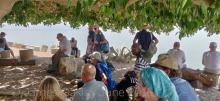
This blog post is part of a series jotting through my trip to Israel in June 2019. For contents page for the posts see the Introductory Post. If I've reported something incorrectly, please let me know via post comments (below) or my contact page. All photographs are Copyright © James Oakley, June 2019, unless indicated otherwise.
Day 7 was a tour of various sites around the northern shore of Galilee.
Our hotel was at the southern end of the lake, just to the east of the outflow of the Jordan. From there, we drove west, through the modern, bustling city of Tiberias (the most populated place around Lake Galilee), to the site of ancient Gennesaret (modern Ginosaur). There we picked up a boat to take us across the lake.
On Lake Galilee
(The actual boats from Jesus' day were much longer and thinner than the one we sailed on - similar in size to a modern bus or coach. One has been retrieved from the mud around the shores of the lake, and is preserved in a museum at Ginosaur, the exhibit being called the "Ancient Galilee Boat" - we did not have time to see this.)

While we were on the boat, one of the boat's crew demonstrated for us the fishing technique from the time of Jesus. A large net with lead weights around the edge is cast into the sea. The net sinks, and is then drawn up by a rope attached to the centre. As you draw the net up, the weights remain on the sea bed, so that any fish under the net are caught in the net and brought into the boat. It's a technique that works best near the shore of the lake, so that the net actually sinks right to the bed.
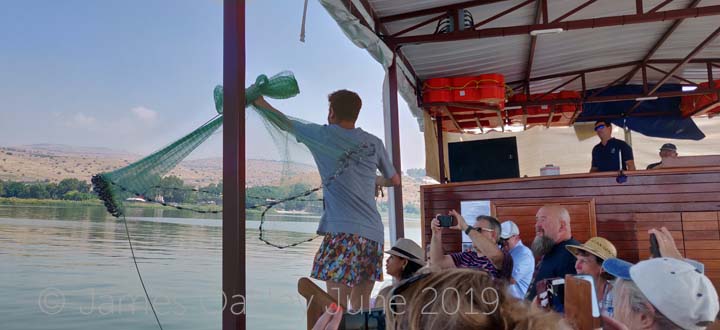
On our day, we fished from both sides of the boat, but caught nothing.
We got off the boat at the jetty in the National Park site at Capernaum; a different part (the older part) of Capernaum was on our itinerary later in the day.
Korazin
First, we drove from the lakeside up the hill to the ruins of ancient Korazin, one of the three towns where we are told Jesus performed most of his miracles.
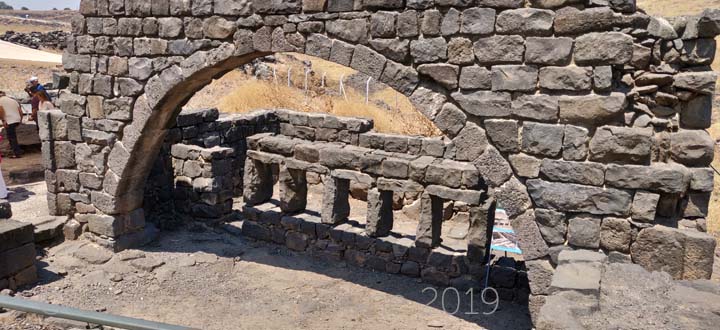
Some of the ruins in Korazin are very well preserved, with pretty much whole houses standing. As I've mentioned in connection with Gethsemane, the empty tomb, and the Bethlehem fields, sometimes you want a place that helps you picture the scene. Jesus healed the paralysed man who was let down through a roof in Capernaum, but Korazin in the same region has some nearly complete houses, and so allowed us to read through that story inside the kind of house where it occurred.
The buildings in Jerusalem were almost all of limestone; here, around the shores of Galilee, we're in volcanic soil and so the dominant rock is the far blacker basalt.
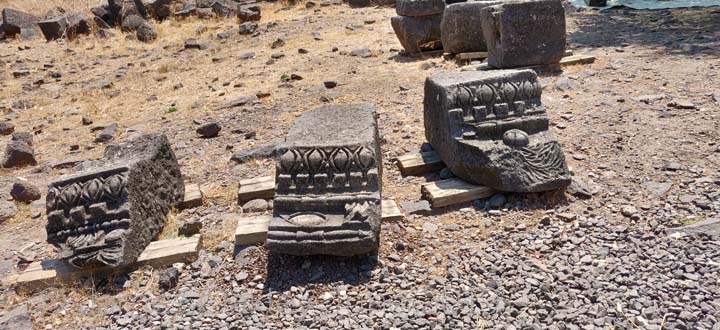
Capernaum
From Korazin, we drove back down the hill to the ruins of the oldest part of Capernaum.
 As well as the seashore, where Jesus walked and called the first disciples, there are two other main things to see in ancient Capernaum.
As well as the seashore, where Jesus walked and called the first disciples, there are two other main things to see in ancient Capernaum.
The home of Simon Peter has been excavated. Ancient grafiti identifies this as his home, making this one of the more certain identified sites we visited. This means it was probably also the home of his mother-in-law, where great crowds came to be healed (Mark 1:29-34).

As often, a church has been built over the site of his home. However this one was built sensitively, so that the ancient site could still be appreciated. Simon Peter's home was accessible from the side of the church, and the floor of the church is glazed in places so you can look down into an earlier church on the site, and around that the remains of his house.

It was striking how close Simon Peter's house is to the synagogue in Capernaum, the other specific place to see whilst in ancient Capernaum.

It was moving to stand in the very synagogue where Jesus himself preached, and where he drove out the impure synagogue of Mark 1:21-28.
(Some of our group thought that the pillar below celebrated the invention of the internet in ancient Capernaum. In fact, it commemorates Fr P Gaudenti Orfali OFM, who helped restore the Capernaum synagogue in 1926. I have no idea what the word "internat" means on this memorial!)
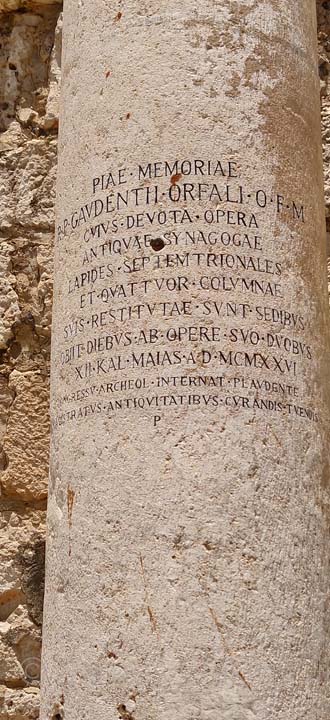
I say it was moving to stand in the actual synagogue. Not quite. The synagogue we stood in dated to the 4th or 5th century, and was (yet again) built over an earlier one. There is one corner of the synagogue site where you can see an older stone layer underneath; these are synagogue stones from the time of Jesus himself.

Recent comments